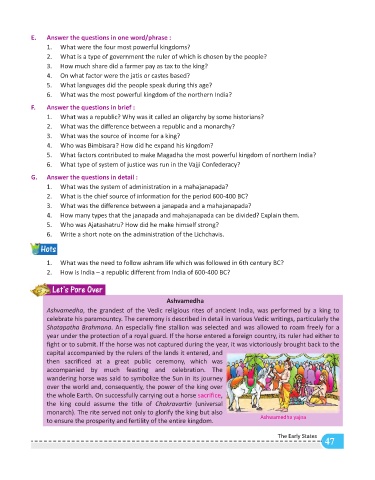Page 47 - SST Class 06
P. 47
E. Answer the questions in one word/phrase :
1. What were the four most powerful kingdoms?
2. What is a type of government the ruler of which is chosen by the people?
3. How much share did a farmer pay as tax to the king?
4. On what factor were the jatis or castes based?
5. What languages did the people speak during this age?
6. What was the most powerful kingdom of the northern India?
F. Answer the questions in brief :
1. What was a republic? Why was it called an oligarchy by some historians?
2. What was the difference between a republic and a monarchy?
3. What was the source of income for a king?
4. Who was Bimbisara? How did he expand his kingdom?
5. What factors contributed to make Magadha the most powerful kingdom of northern India?
6. What type of system of justice was run in the Vajji Confederacy?
G. Answer the questions in detail :
1. What was the system of administration in a mahajanapada?
2. What is the chief source of information for the period 600-400 BC?
3. What was the difference between a janapada and a mahajanapada?
4. How many types that the janapada and mahajanapada can be divided? Explain them.
5. Who was Ajatashatru? How did he make himself strong?
6. Write a short note on the administration of the Lichchavis.
1. What was the need to follow ashram life which was followed in 6th century BC?
2. How is India – a republic different from India of 600-400 BC?
Ashvamedha
Ashvamedha, the grandest of the Vedic religious rites of ancient India, was performed by a king to
celebrate his paramountcy. The ceremony is described in detail in various Vedic writings, particularly the
Shatapatha Brahmana. An especially fine stallion was selected and was allowed to roam freely for a
year under the protection of a royal guard. If the horse entered a foreign country, its ruler had either to
fight or to submit. If the horse was not captured during the year, it was victoriously brought back to the
capital accompanied by the rulers of the lands it entered, and
then sacrificed at a great public ceremony, which was
accompanied by much feasting and celebration. The
wandering horse was said to symbolize the Sun in its journey
over the world and, consequently, the power of the king over
the whole Earth. On successfully carrying out a horse sacrifice ,
the king could assume the title of Chakravartin (universal
monarch). The rite served not only to glorify the king but also
Ashwamedha yajna
to ensure the prosperity and fertility of the entire kingdom.
The Early States
47

